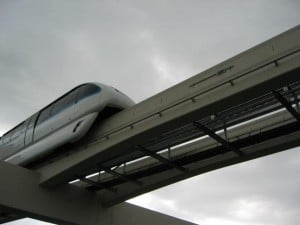There is no question there is great demand in terms of bringing the nation’s roadway infrastructure to a state of good repair.
Now add to this also, highways nationwide suffer a 42 percent congestion rate, this according to the American Society of Civil Engineers.
It is no secret that U.S. roadways versus airways versus railways, roadways receive the lion’s share of funding.
At first glance this may seem sensible because, here in America, based on mileage roadways lead the way with railways pulling up the rear: 4 million lane-miles of asphalt/concrete to railways’ approximately 200,000 rail-route miles of track – a 20 to 1 ratio. Aviation being a different animal entirely, such weighs in at somewhere in the neighborhood of 50,000 scheduled commercial flights daily.
Now consider there has been a downward trend in vehicle miles driven on America’s vast roadway network recently and it begins to make perfect sense that some folks would think a commensurate lowering of roadway spending would be, excuse the expression, just what the doctor ordered.
Chris McCahill at the State Smart Transportation Initiative (SSTI) states, “Unlike other past dips in driving, this recent downward shift has had no clear, lasting connection to economic trends or gas prices. Evidence suggests that the decline is likely due to changing demographics, saturated highways, and a rising preference for compact, mixed-use neighborhoods, which reduce the need for driving. Some key factors that pushed VMT upward for decades – including a growing workforce and rising automobile ownership – have also slowed considerably. SSTI released a report last September outlining the many contributing factors, with references to supporting literature.”

Alternatively, with the efficiency, environmental sustainability and maintainability aspects of railroading being what they are, it is no wonder I have such a difficult time understanding why domestically there isn’t more of this kind of infrastructure development than what there currently is. Truth be told, seems like a no-brainer.
And, while it may be true railway infrastructure is by far the most expensive of the three when it comes to construction costs, that, in and of itself, is not a valid reason not to allocate a higher percentage of funding to railways. If one is inclined to frame this as highway robbery, think nothing of the sort. If anything, there is the potential for a better balance in transportation infrastructure spending to be brought about.
By most measures, there is far greater return on investment with railways, even public-serving passenger railways – meaning they typically provide a big if not the biggest bang for the buck. This has been proven time and time again.
The above are but a few reasons I feel the percentage of funding for roads could stand to be less one infrastructure type compared to another.
In spite of railway transportation’s many advantages, in my humble opinion spending on the public railway infrastructure side in this case has taken not a back, but a rumble seat. Remember those? Talk about a “fair share” imbalance, this would be it – a “what’s-wrong-with-this-picture” moment if ever there was one!
And besides, being that In California there are laws on the books requiring that greenhouse gas emissions be significantly lowered, and since, in California, according to the Public Policy Institute of California (PPIC), 37 percent of GHG comes from transportation, the largest source (about three quarters) of such emissions being from the roadway sector (passenger cars and trucks), and that “[California] Assembly Bill (AB) 32, the Global Warming Solutions Act of 2006, set a target for California to reduce statewide emissions to 1990 levels by 2020 (a roughly 30 percent reduction relative to business as usual), and the state is aiming to reduce emissions an additional 80 percent by 2050 …,” wrote Louise Bedsworth, Ellen Hanak and Jed Kolko in the PPIC report: “Driving Change: Reducing Vehicle Miles Traveled in California,”1 all things considered, investing more and more money in roadway projects in state, to me, makes little sense.
Notes
- © 2011 Public Policy Institute of California. All rights reserved. San Francisco, CA
– Alan Kandel